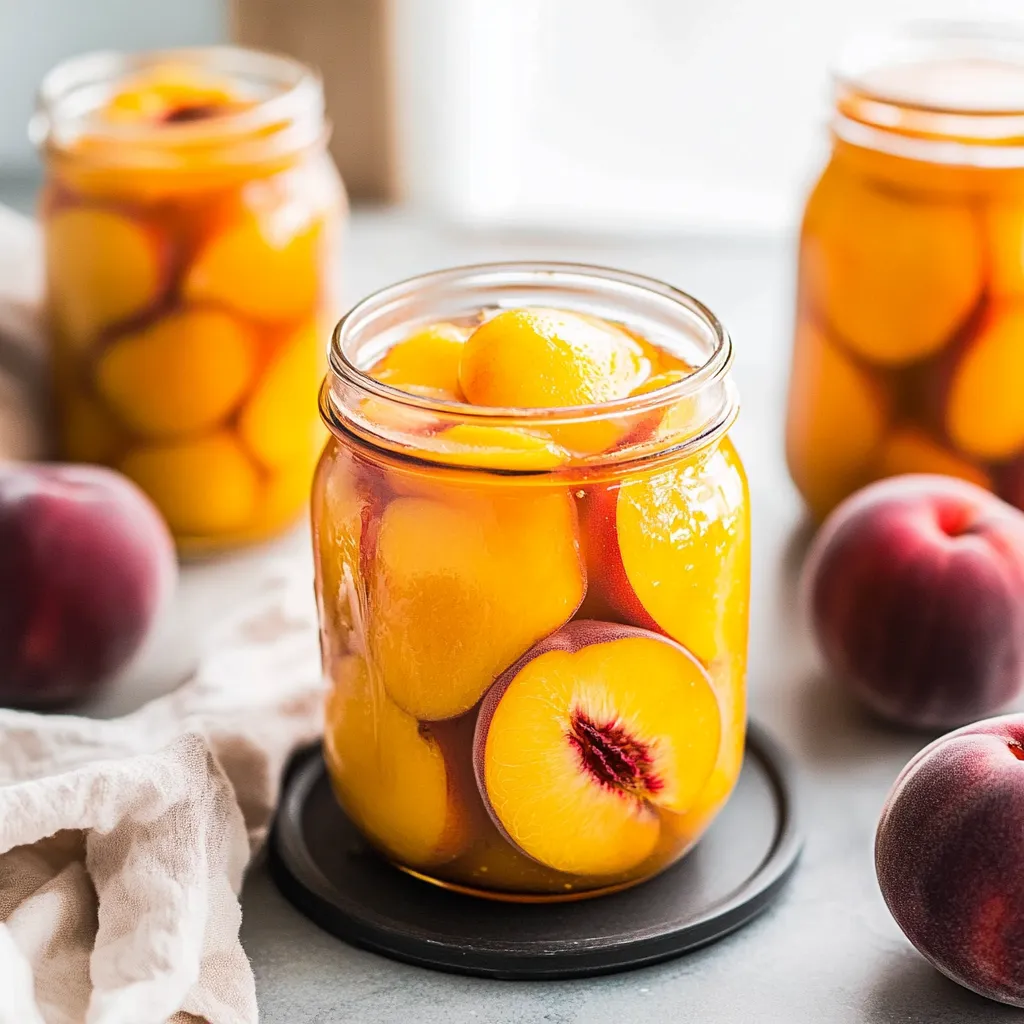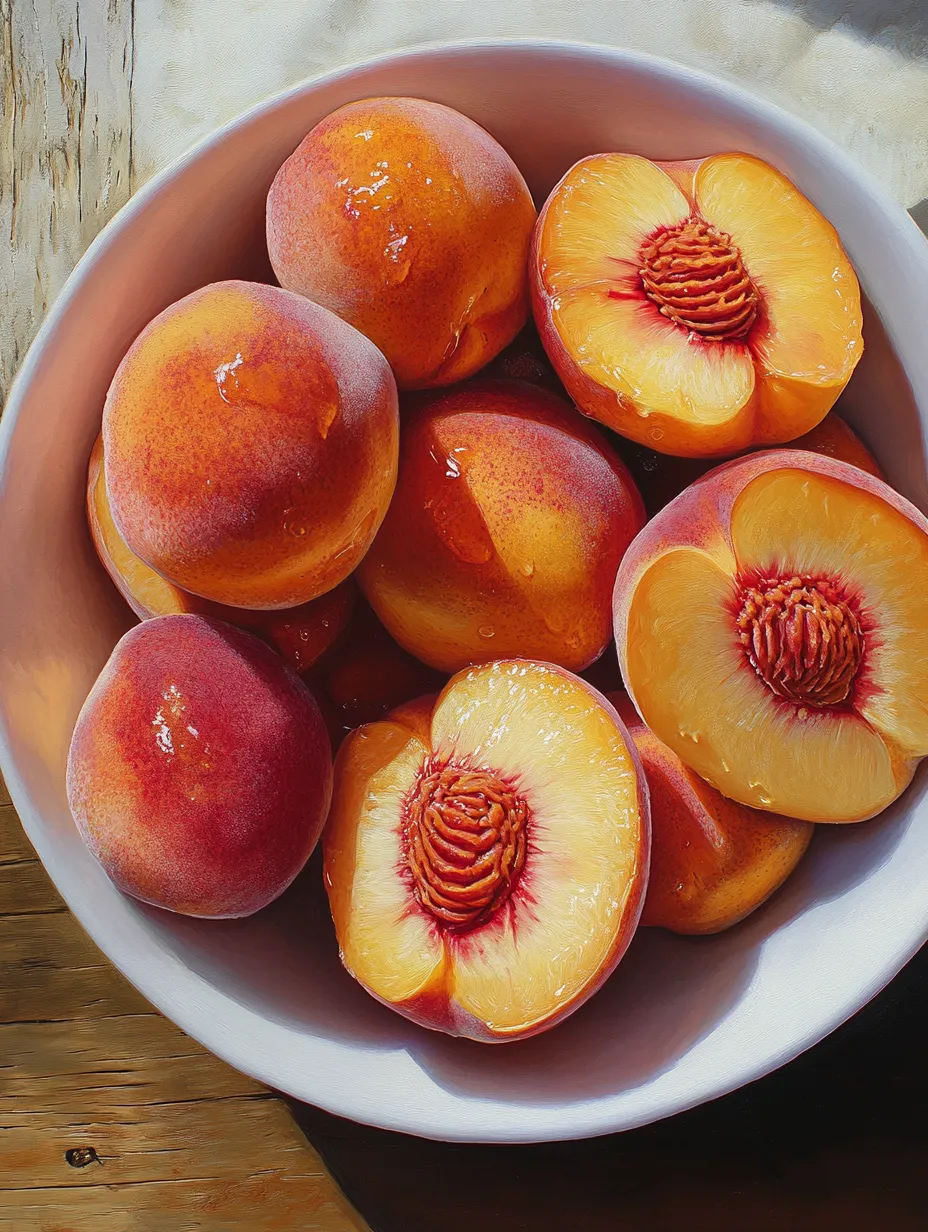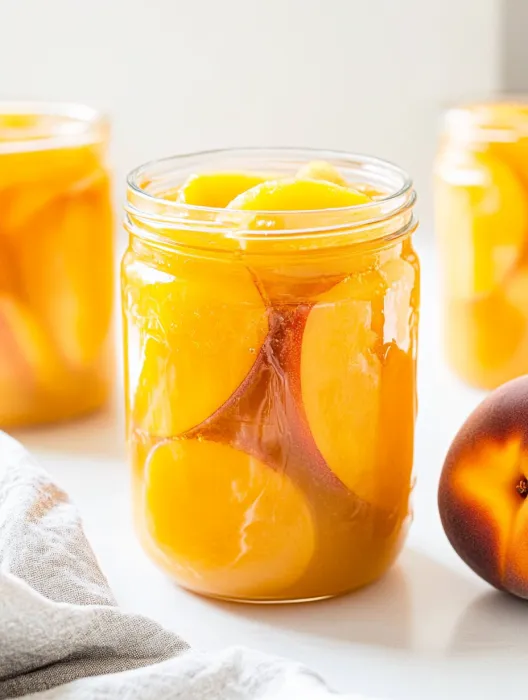 Highlight
Highlight
This classic peach canning method has been my summer ritual for over a decade, preserving the sunshine sweetness of peak-season peaches to enjoy all year long. The process might seem intimidating at first, but once you taste these homemade canned peaches in January, you'll understand why this tradition is worth keeping alive.
I first learned this method from my grandmother, who would spend August afternoons filling her pantry with gleaming jars of golden peaches. Now my children help me each summer, eagerly awaiting the moment they can hear the satisfying "ping" of each successfully sealed jar.
Ingredients
- Fresh ripe peaches preferably freestone varieties for easier pitting and vibrant flavor
- Granulated sugar creates the perfect syrup consistency while helping preserve the fruit
- Clean quart jars with rings and new lids new lids ensure a proper seal every time
- Water the base of your syrup and processing medium
Step-by-Step Instructions
- Sterilize Your Jars
- Begin by running jars and rings through a hot dishwasher cycle or boiling them for 10 minutes. The cleanliness ensures no bacteria will contaminate your preserves and helps create a proper seal. Remember that lids should be new and unused for safety.
- Prepare Your Water Bath
- Fill your canner with enough water to cover the jars by 1-2 inches. Bring to a boil, then reduce to a simmer while you prepare the peaches. This preheating step saves time later in the process.
- Peel the Peaches
- Blanch peaches in simmering water for 30 seconds before plunging into an ice bath. The skins will slip off effortlessly with gentle pressure from your fingers. This technique preserves more fruit flesh than peeling with a knife and creates a better texture in the final product.
- Pack the Jars
- Slice peeled peaches directly into jars, packing them quite full. Tap jars gently on countertop to help fruit settle naturally. The goal is to maximize fruit content while still leaving room for syrup to penetrate between slices.
- Add Simple Syrup
- Combine hot water with sugar according to your sweetness preference. Pour syrup over packed peaches, leaving 1/2 inch headspace at top. The headspace allows for expansion during processing while still ensuring the fruit remains covered.
- Seal and Process
- Wipe jar rims clean, apply new lids, and secure with rings. Process in boiling water bath for 25 minutes at sea level, adjusting for altitude as needed. The heat creates a vacuum seal that preserves the peaches while killing any potential spoilage organisms.

The most satisfying moment in this entire process is hearing the symphony of "pings" as each jar seals properly after cooling. It's a sound that signifies success and reminds me of my grandmother's kitchen every single time.
Syrup Variations
Creating the right syrup is crucial for flavor and preservation. For traditional sweet syrup, use a 2:1 ratio of water to sugar. If you prefer a lighter option, reduce sugar to 1 cup per 4 cups water. For those watching sugar intake, you can substitute honey using 3/4 cup honey for each cup of sugar called for. The syrup not only sweetens but helps maintain the color and texture of your peaches throughout their shelf life.
Troubleshooting Common Issues
Fruit floating to the top occurs when peaches aren't fully ripe or are packed too loosely. To prevent this, use tree-ripened fruit and pack jars firmly. If floating still occurs, the peaches are still perfectly safe to eat. Discoloration near the top of the jar typically indicates oxidation from air exposure. Using fruit-fresh or lemon juice in your syrup can help prevent browning, but minor discoloration doesn't affect taste or safety.
Creative Serving Ideas
Transform your canned peaches into elegant desserts by serving them over vanilla ice cream or pound cake. For breakfast, warm slightly and spoon over oatmeal or yogurt with a sprinkle of granola. During holiday gatherings, I often create a stunning trifle by layering canned peaches with custard and cake for a show-stopping dessert that reminds everyone of summer even in December.

Common Questions About the Recipe
- → How long do home-canned peaches last?
Properly sealed and stored home-canned peaches maintain best quality for 12-18 months when kept in a cool, dry place. They may remain safe to eat even longer, but quality gradually diminishes. Always check for signs of spoilage before consuming.
- → Can I can peaches without sugar?
Yes, you can substitute the sugar syrup with fruit juice or a honey mixture. While sugar helps maintain texture and color, alternatives work well for those limiting sugar intake. Follow the proper substitution ratios in the recipe to ensure safe preservation.
- → What's the difference between hot pack and raw pack methods?
The raw pack method involves placing uncooked peach slices directly into jars with hot syrup, while hot pack requires briefly simmering the peaches in syrup before jarring. Hot pack typically yields more peaches per jar and requires slightly longer processing time (30 minutes versus 25).
- → How do I know if my canned peaches have sealed properly?
After cooling for several hours, press the center of each lid. Properly sealed lids will be concave and firm, making no popping sound when pressed. If the lid flexes or makes a popping noise, the jar hasn't sealed correctly and should be refrigerated for immediate use or reprocessed.
- → What type of peaches work best for canning?
Freestone peaches work best for canning as their flesh separates easily from the pit. Avoid white peaches as they're typically lower in acid, which affects safe preservation. Choose ripe but firm peaches with good color and no bruises for best results.
- → Do I need a special canner or can I use a regular pot?
While a water bath canner is ideal, you can use a large stockpot as long as it's deep enough to cover the jars with 1-2 inches of water and has a rack to prevent jars from touching the bottom. Ensure the pot allows for proper water circulation around all jars.
